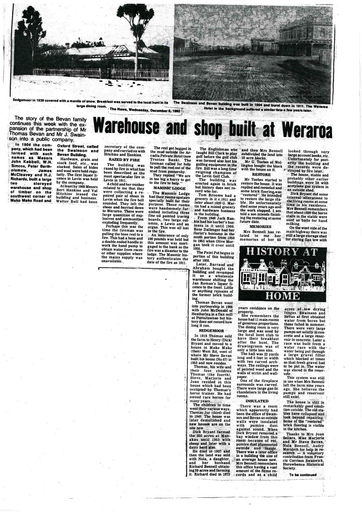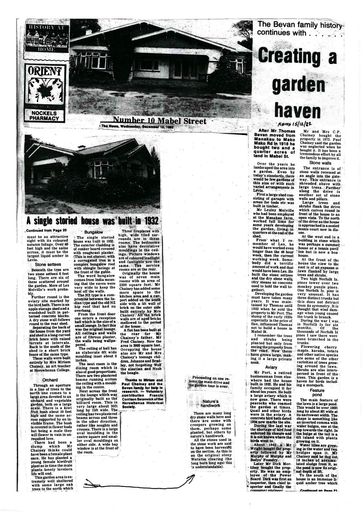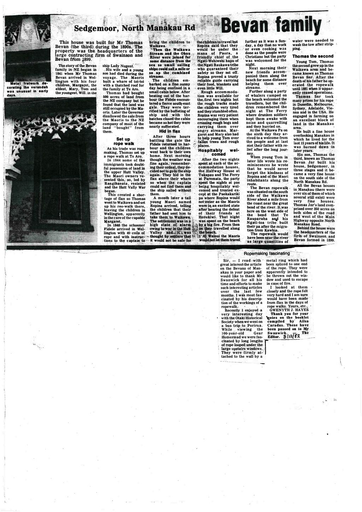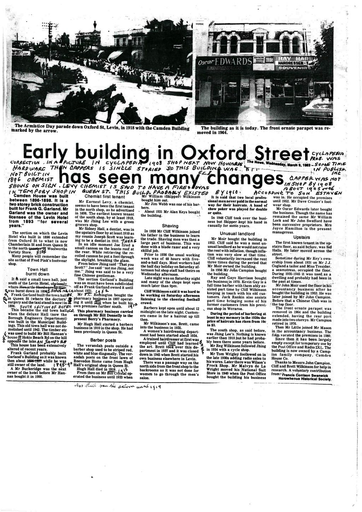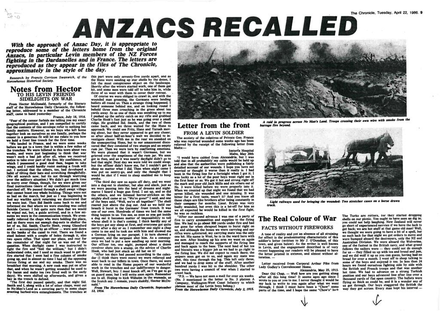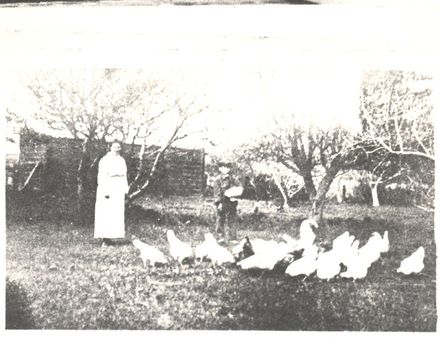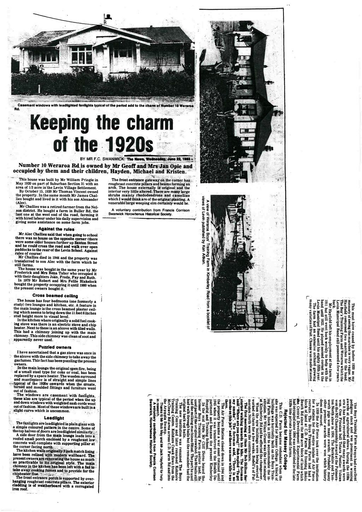Timber was all heart as befitted a sawmiller’s house
- Description
The original bush in the Levin area stretched from an approximate north-south line from the east side of Lake Horowhenua to up into the Tararua Ranges.
Of the timber trees matai was the most dominant but there were also many totara and some rimu. Most other species were left to the settlers axe and fire. The trees felled for milling had to be large, at least two to three feet in diameter.
As the timber was cut out round Levin a tramline was extended to the east from the Weraroa mill across country into the Ohau Valley (Gladstone Rd). This turned into the valley where Water Treatment Works and the settling tanks are now.
Evacuation bridge
A branch sawmill was built over the Ohau River where a private bridge is now on Mr Leo Gimblett’s farm. This was the site of the evacuation bridge built during World War II to evacuate the people of Levin if the Japanese invaded the Horowhenua coast.
One tram line from this mill ran east and up Mill Creek which joins the Makeretu Stream just inside the present bushline. The tram ran up Mill Creek past Dead Man’s Gully where an unidentified skeleton was found in the 1920s.
Forty years ago the rails of the tram still existed and probably still do. At least the cuttings into the ridgeside will still exist. Forty years ago the mill site was marked by sawdust heaps and some relics of machinery.
These tram lines were usually timber but some steel rails were used by at least one of the sawmills in the Levin area. The timber rails were four inches by four inches and the sleepers were split out of the trees in the bush at the side of the tram.
Hitched rides
The late Mr Bill Clark related how he hitched rides on an empty trolley to the upper Ohau River for a days fishing.
The rails of the tram must have been laid across the bed of the river. A story I heard before 1920 was of a neighbour who drove a trolley on the tram from this upper mill to Weraroa. He was said to have got very wet when the horses splashed through the river. This mill was established by at least 1907 but could have been there some years before. It was a breaking down mill turning logs into flitches to be further sawn and planed at the Weraroa mill.
Another mill was established, or the Ohau River one shifted, to up the Makahika Stream. This was sited just over the Makahika Stream bridge on the east side of the road about a mile past the Pipe Bridge on the Gladstone Rd. The foundations were still there a few years ago. A small red whare existed there for many years. The date this mill operated can only be guessed as about 1910-13.
The tram system apparently ran all the way up to the top of the Makahika Valley. A tram went into what used to be called Greenaway’s bush or “the six hundred”. This block ran up the east side of the Arapaepae foothills just before the Waiiti stream. A bridge was across the Makahika Stream over a deep chasm.
Stories vary that the bridge collapsed with a trolley on it killing the horses or the driver or both.
Bartholomew’s mills must have taken the timber off the whole Ohau Valley, the Makahika Valley of what is cleared country now, and up both branches of the Waiiti Stream.
In my memory of the early 1920’s most of the country was cleared of bush though a lot had gone back to fern and scrub. Knight Brothers sawmill only started in the early 1920’s and took timber from what was still existing bush.
The tram lines were of four foot gauge with the rails nailed to rough sleepers. Curves were apparently easy to put into the tram line as there were plenty of them. Sawdust was often spread between the rails making a softer and drier footing for the horses.
In her first book, My First Eighty Years, Helen Wilson described the tram line to her section as a symmetrical tunnel through a gigantic fernery, the greenery contrasting with the red sawdust.
The damage done in the cutting had healed. Groves of tree ferns with their white backed fronds made a fretted ceiling.
Steam haulers were used to bring logs to the tram. Wire ropes were taken through the bush to the logs and the winch on the hauler dragged them back to the tram. These haulers were used especially in hilly country.
All Bartholomew sawmills apparently ceased working about 1913 or 1914.
Little left
When my family moved to Beach Rd in 1916 there was very little left of the Weraroa sawmill. A small building existed in Oxford St somewhere about the rear of Mullan’s factory apparently the mill office. Concrete foundations were visible and plenty of sawdust piles. Nobody wanted sawdust then.
Two lavatories remained where we children dropped stones down the holes. It seemed many seconds before the sound of the stones hitting the bottom was heard.
There were many rusting bandsaws about10 inches wide and 20 feet long lying about. Mr Bill Watkins of Beach Rd had three raised circular flowerbeds about six feet wide formed by these bandsaws.
Grass was growing on the mill site indicating some years of abandonment. The ditch leading from the roadline, deepening from road level to about four or five feet at the mill site, was visible for years until a house was built over it and the front of the section levelled. It is still visible under Gypsy Hire Centre.
Shortcut
The mill block, until subdivision, was a holding paddock for stock. When we shortcutted to school a wary eye had to be kept if bulls were in the paddock. Fortunately there was a fence halfway so had a choice of routes.
The mill paddock across the road from our house was our playground for football and cricket. The ground surface was very uneven and the only place that was at all suitable for a cricket pitch had a large log nearby which was an efficient fieldsman.
The log was said to have killed a man at the mill and was discarded. This did not prevent 60 year old Mrs Carlson from living in a house built later from cutting the log into firewood.
Once when a good kick put our football over on to the road a passing truck flattened it.
It took many hours of cleaning eggs at 1c a dozen to save enough money to have the case repaired and buy a new inside liner. We were past using the pet pig’s bladder, blown up, for a football.
In 1924 the block was subdivided into quarter acre sections. There were only two houses built on it, one where Granny’s Liquorice factory is now and one on the Mabel St-Beach Rd corner, both Bartholomew houses.
An auction was held. Sections on Oxford St went for up to 80 pounds with most of the remainder for 64 pounds. The railways department built several houses in Keepa St. McKenzie St was extended through to Beach Rd. at least the land was given to the borough council. The council had no policy of the subdivider building roads and footpaths then. The road remained a rough track where residents dumped their stones until about 1940 or even later until the council found money to improve it. It was a rocky road to drive over. Gradually the block was built on and the area that had been one of Levin’s first industries became a residential area.
During the depression of the early 1930s Mr Herrick asked my father to buy a section in Beach Rd for the original price of $64 but with eggs about 9c a dozen $64 was a small fortune. [₤32 and ₤40 were section prices.]
Thanks for help in research to Mr Peter Bartholomew and family. Also thanks to Mr and Mrs Marlow for assistance.
Identification
- Date
- May 25, 1983
Taxonomy
- Community Tags




